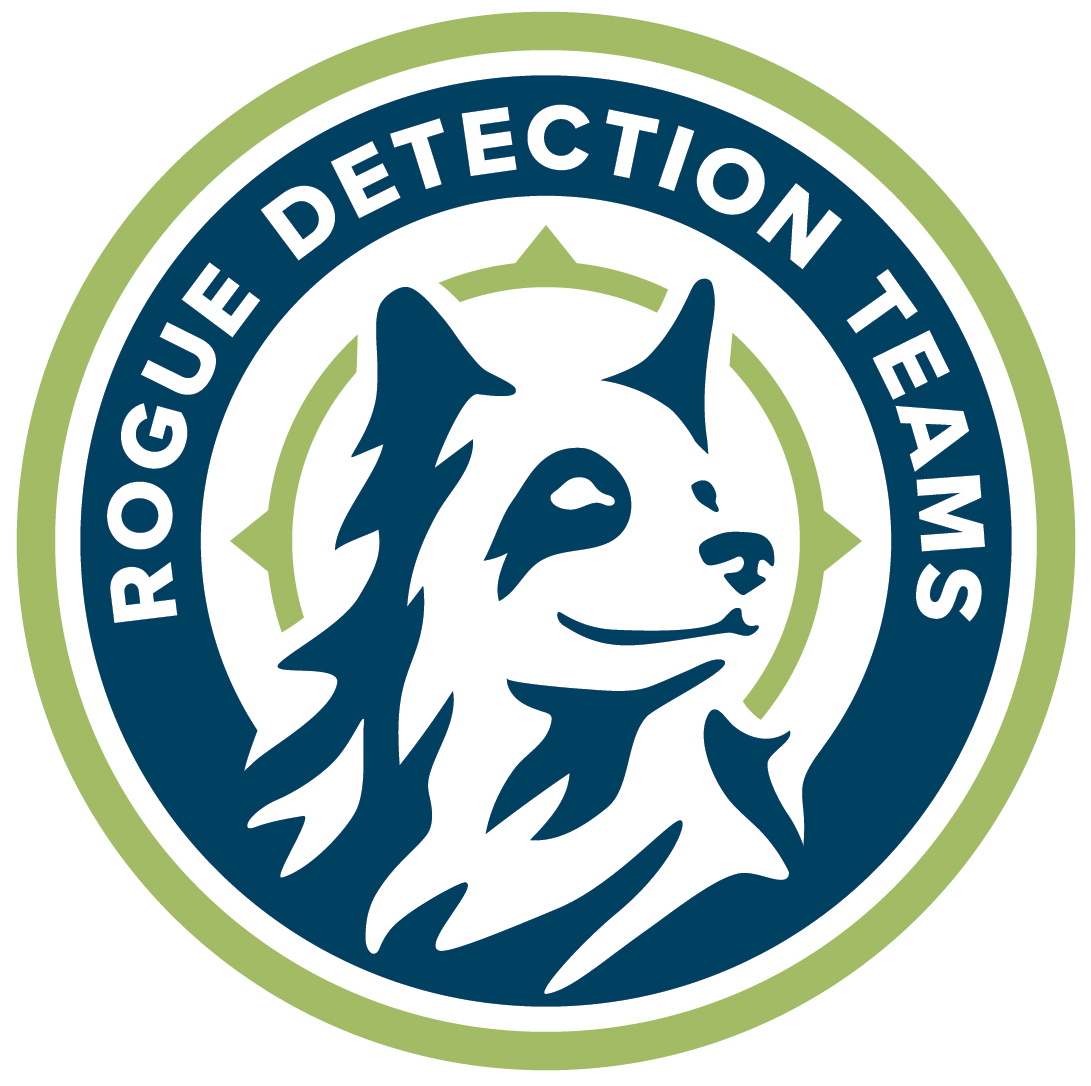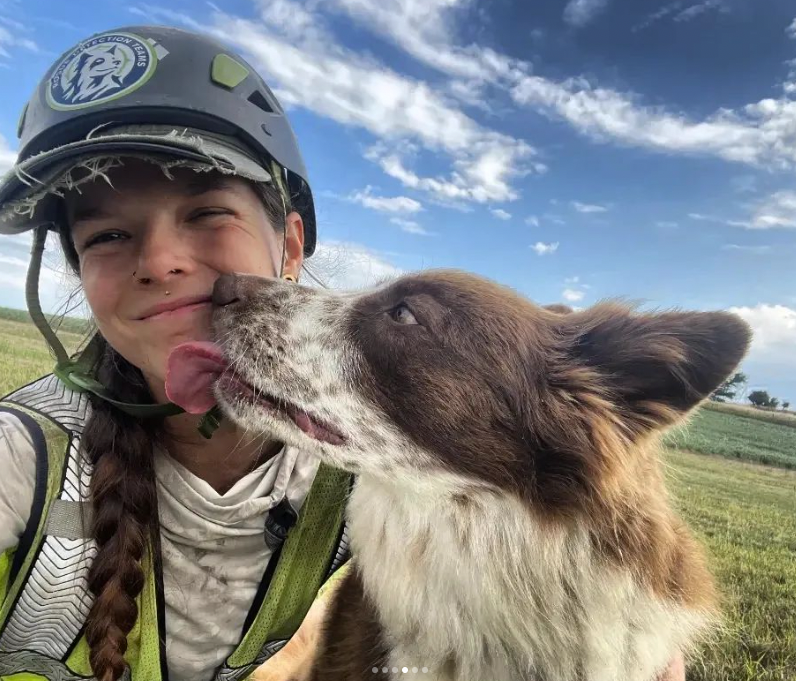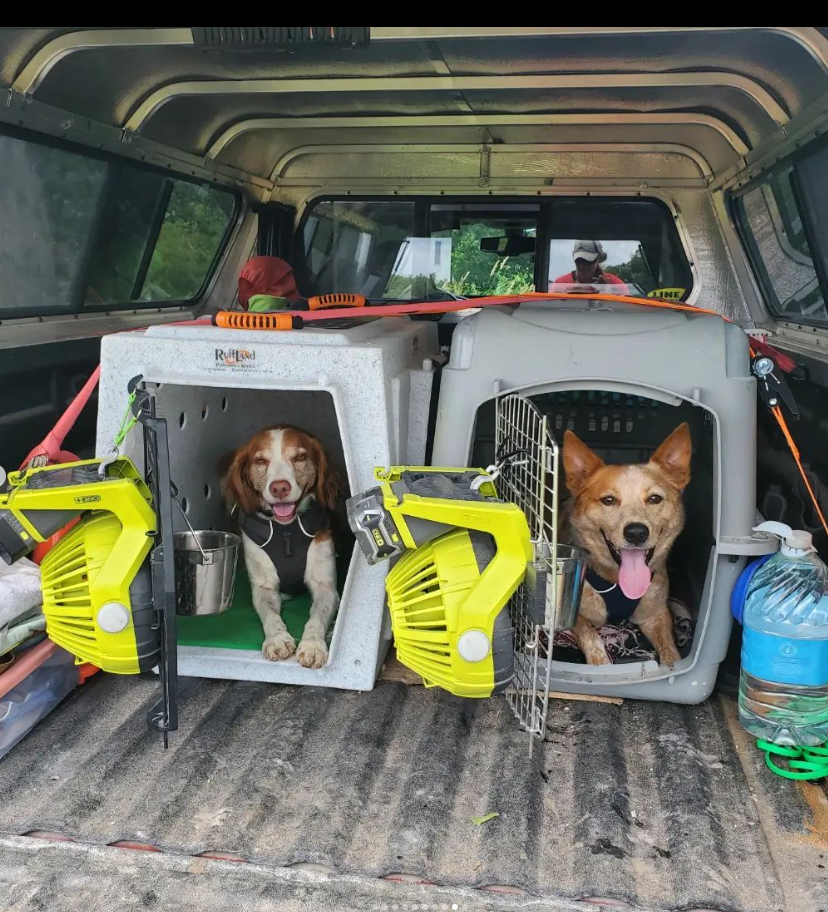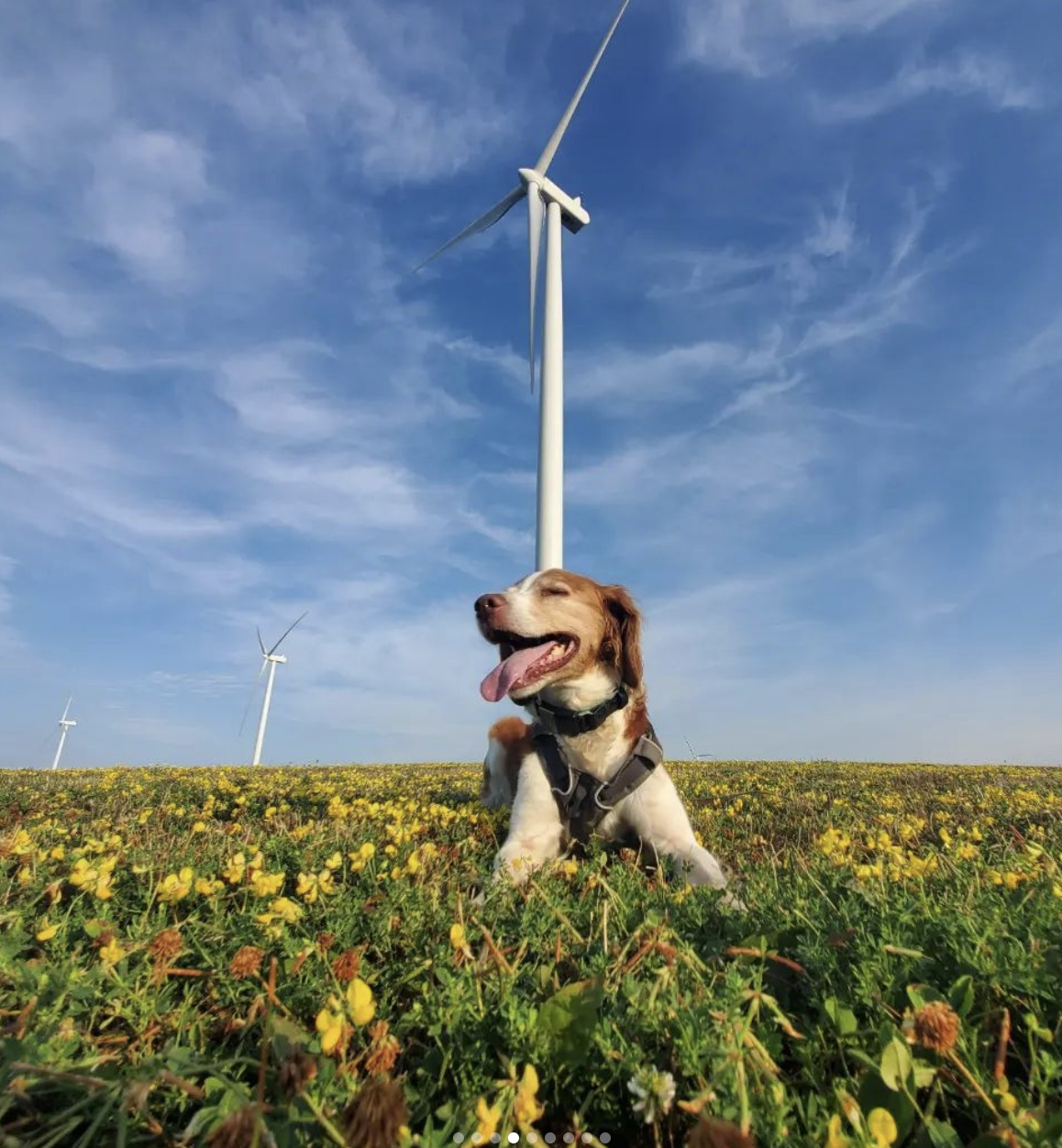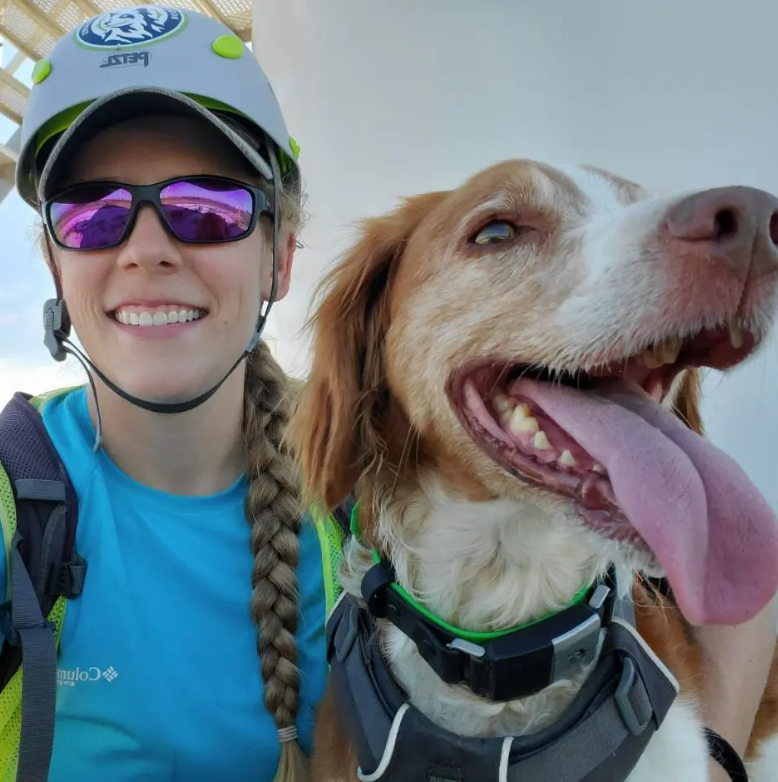A Look Back at 2022
We’re officially one month into the New Year, and while some might be looking back on their January and assessing how the first month of 2023 went, we’re taking it one step further and looking back allllll the way to last year. That’s right, it’s time for a (somewhat belated) recap of 2022, the incredible field work that our detection teams did, and the other antics that we got up to from January to December.
Without further ado, please enjoy our 2022 Rogue Roundup!
Field Work:
The bulk of our time is spent out in the field, sometimes for several weeks (or months), and 2022 was no different.
 In April we wrapped up a three-year research project in southern California where our detection teams have been searching for avian mortalities at wind facilities in partnership with USGS, the Bureau of Land Management, and other partners. Two of our bat dog extraordinaires, Ptero (named after a fruit bat!) and Lady have been instrumental in helping researchers learn more about the effects of wind energy. The data they and our other bat dogs sniff informs best management practices for both bats and birds.
In April we wrapped up a three-year research project in southern California where our detection teams have been searching for avian mortalities at wind facilities in partnership with USGS, the Bureau of Land Management, and other partners. Two of our bat dog extraordinaires, Ptero (named after a fruit bat!) and Lady have been instrumental in helping researchers learn more about the effects of wind energy. The data they and our other bat dogs sniff informs best management practices for both bats and birds.
 Ptero and Lady, along with bounder Justin Broderick, battled intense daytime temps and switch their search times to night, to avoid dangerous heat. They also helped locate endangered plants (Coachella milk-vetch) as a side hustle! According to KCET: "Though the Coachella Valley milk-vetch is protected as an Endangered species, it's not actually a species, but a variety —Astragalus lentiginosus var. coachellae—of a larger species, Astragalus lentiginosus. It's the least abundant... with only about 20 populations recorded in the last two decades—all of them within three miles of Interstate 10.”
Ptero and Lady, along with bounder Justin Broderick, battled intense daytime temps and switch their search times to night, to avoid dangerous heat. They also helped locate endangered plants (Coachella milk-vetch) as a side hustle! According to KCET: "Though the Coachella Valley milk-vetch is protected as an Endangered species, it's not actually a species, but a variety —Astragalus lentiginosus var. coachellae—of a larger species, Astragalus lentiginosus. It's the least abundant... with only about 20 populations recorded in the last two decades—all of them within three miles of Interstate 10.”
Endangered Oregon Silverspot Butterflies - Oregon Coast
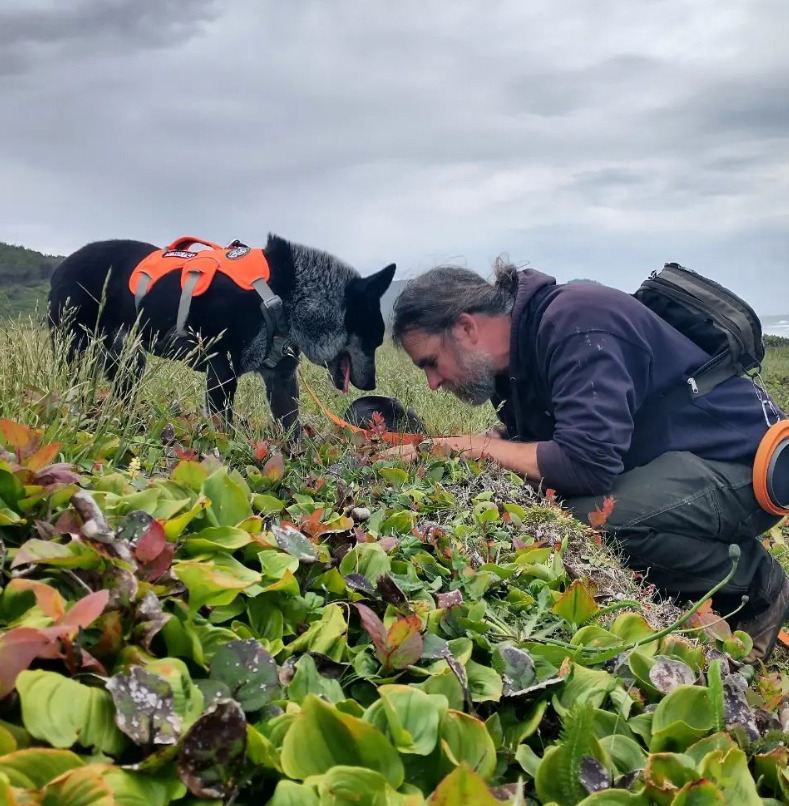 In June we went back to the Oregon Coast for some Oregon Silverspot butterfly detection work. In 2021, our own Pips made history for locating larvae of the threatened Silverspot for the FIRST TIME in the wild in over 40 years! Pip's nose was much better than human eyes at locating these teeny-tiny targets, but our project partners were able to confirm over a dozen locations. Pips helped confirm that the captive breeding program assisting this species' recovery was indeed working! Awooo! In 2022 we were back on this project and continued Pip's sniff-tastic legacy in pollinator conservation efforts, and brought in some additional detection dog nose help from Filson, Whisper, and Willow. This work was conducted with special USFWS permits. Collaborators included US Forest Service, Siuslaw National Forest, Pacific University, Oregon Zoo, and others.
In June we went back to the Oregon Coast for some Oregon Silverspot butterfly detection work. In 2021, our own Pips made history for locating larvae of the threatened Silverspot for the FIRST TIME in the wild in over 40 years! Pip's nose was much better than human eyes at locating these teeny-tiny targets, but our project partners were able to confirm over a dozen locations. Pips helped confirm that the captive breeding program assisting this species' recovery was indeed working! Awooo! In 2022 we were back on this project and continued Pip's sniff-tastic legacy in pollinator conservation efforts, and brought in some additional detection dog nose help from Filson, Whisper, and Willow. This work was conducted with special USFWS permits. Collaborators included US Forest Service, Siuslaw National Forest, Pacific University, Oregon Zoo, and others.
Wind Energy Facilities and Avian/Bat Mortalities - Iowa
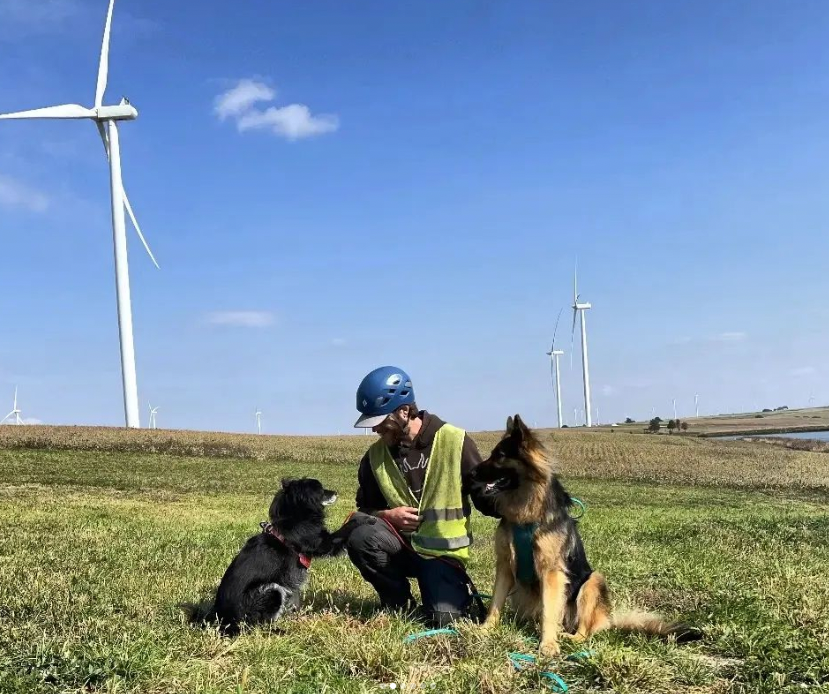 Our biggest project in 2022 was in partnership with Bat Conservation International and took place in Iowa, where bounders Julia, Abby, Grace, Justin, Christina, Celeste, Skye, and London were stationed from June through October with detection dogs (brace yourself): Ranger, Ptero, Beckett, Dusty, Blitz, Violet, Siska, Cricket, Winnie, Hugo, Cosmo, Jekyll, Indy, Maple, Lady, Dio, and Mocha. Whew! The objective: survey wind facilities for bat and bird mortalities. The challenge(s): extreme heat, intense humidity, very early mornings, and long commutes.
Our biggest project in 2022 was in partnership with Bat Conservation International and took place in Iowa, where bounders Julia, Abby, Grace, Justin, Christina, Celeste, Skye, and London were stationed from June through October with detection dogs (brace yourself): Ranger, Ptero, Beckett, Dusty, Blitz, Violet, Siska, Cricket, Winnie, Hugo, Cosmo, Jekyll, Indy, Maple, Lady, Dio, and Mocha. Whew! The objective: survey wind facilities for bat and bird mortalities. The challenge(s): extreme heat, intense humidity, very early mornings, and long commutes.
In an excellent article put out by Bat Conservation International (see link below), bounder Julia Nawocki, along with detection dogs Dusty and Blitz, were featured in their wind facility work:
"The dogs and Nawrocki are on the road long before sunrise to drive an hour to one of Iowa’s sweeping wind energy installations. As the sun begins to rise, Nawrocki will bring one of the dogs to survey for miles under towering turbines. Meanwhile, the other dogs will wait in a comfortably cooled crate and join Nawrocki later so that both dogs have plenty of time to rest and don’t get overworked.”
The data we collect is heart wrenching—it’s never fun to find wildlife carcasses—but we do this work in the hopes that the research will lead to a better understanding of what's occurring at wind facilities and how we can best mitigate both bird and bat losses.
Great work to all of our detection teams who worked diligently through hard conditions in Iowa!
Articles about this project:
https://digital.batcon.org/issue/volume-41-issue-3/data-dogs/
Multi-Species Surveys - S. Oregon
 Later in the year, Whisper, Filson, and Rogue mascot Willow spent several weeks working on the Oregon Carnivore Project, led by Oregon State University. We surveyed for mountain lion, wolf, bobcat, coyote, fisher, marten, and porcupine.
Later in the year, Whisper, Filson, and Rogue mascot Willow spent several weeks working on the Oregon Carnivore Project, led by Oregon State University. We surveyed for mountain lion, wolf, bobcat, coyote, fisher, marten, and porcupine.
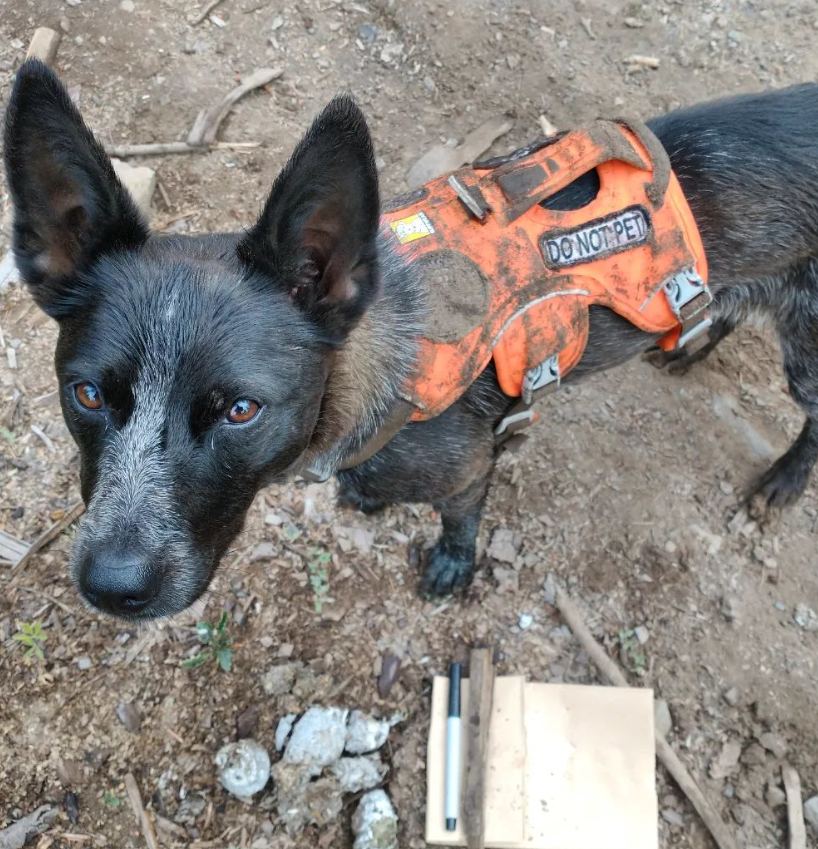
Over this multi-week, multi-species survey in southwest Oregon, our teams camped, had early morning commutes on rugged mountain roads, climbed super steep terrain, crossed dewy meadows, hiked miles of dusty, overgrown roads, clambered over giant down trees, cooled off in cool streams (and mud holes), tried to avoid poison oak, got stung by ground nesting wasps, and discovered remnant old growth forests, all in the name of noninvasive conservation science! We also dealt with extreme heat and smoky, poor air quality due to wildfires—never a dull moment here in the Northwest!
Articles about this project:
Sierra Nevada Red Fox Surveys - California
In October, we kicked off Year 5 of collaborating with UC Davis’ Mammalian Ecology & Conservation Unit, as well as researchers Dr. Quinn and Dr. Sacks, and went to the Sierra Nevadas with detection dog Filson to detect endangered Sierra Nevada red fox (vulpes vulpes necator).
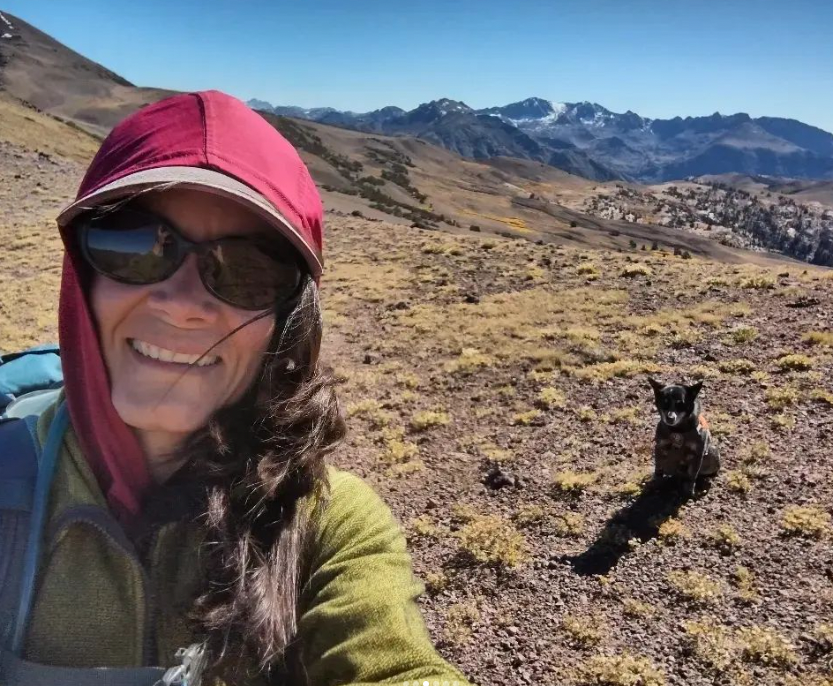 Sierra Nevada red fox work is one of our most rugged projects, requiring our detection teams like Filson to acclimate to 10,000+ ft elevation, backpack into wildernesses for days at a time, and have our dogs wear protective booties due to abrasive volcanic rock—all to sniff for teeny tiny data of one of North America's rarest mammals.
Sierra Nevada red fox work is one of our most rugged projects, requiring our detection teams like Filson to acclimate to 10,000+ ft elevation, backpack into wildernesses for days at a time, and have our dogs wear protective booties due to abrasive volcanic rock—all to sniff for teeny tiny data of one of North America's rarest mammals.
According to the US Fish & Wildlife Service: “The Sierra Nevada Distinct Population Segment was listed as endangered in 2021. Only about 18 to 39 individuals remain in the wild today."
 We started this project later in the year than we ever have, and crossed our fingers to get in and out before the first snow closed access to our remote location. We battled some incredibly cold, long nights (we car camp and backpack for this project). Over the course of a two-day stint, Whisper and Filson collectively hiked 50 miles—if you factor in elevations of 10,000+ feet, that's like running a marathon! Each day included at least eight hours of hiking and 1.5 hours prepping samples for analysis after returning to camp. We’re not sure how we did it, but we squeezed in our last survey for this year right before the first snow came. And we got to enjoy the aspens in full "bloom" across our study area, which utterly took our breath away. #WorthIt!!
We started this project later in the year than we ever have, and crossed our fingers to get in and out before the first snow closed access to our remote location. We battled some incredibly cold, long nights (we car camp and backpack for this project). Over the course of a two-day stint, Whisper and Filson collectively hiked 50 miles—if you factor in elevations of 10,000+ feet, that's like running a marathon! Each day included at least eight hours of hiking and 1.5 hours prepping samples for analysis after returning to camp. We’re not sure how we did it, but we squeezed in our last survey for this year right before the first snow came. And we got to enjoy the aspens in full "bloom" across our study area, which utterly took our breath away. #WorthIt!!
As always, we're delighted to be assisting UC Davis and Drs. Quinn and Sacks on their long-term genetic study of this at-risk species.
Mountain Lion Surveys - S. California
Our last field work of the year took place in southern California, and we traded rugged wilderness views for an urban backdrop. We got to partner with the California Mountain Lion Project to survey for…you got it, mountain lions! You may not think of mountain lions as an urban species, but in southern California this elusive species can be found in the midst of human sprawl. A wide-ranging animal, the mountain lion’s habitat has been fragmented due to freeways and other roadways, as well as human development, which hampers lions’ abilities to find mates.
 "Research indicates a lack of genetic diversity in specific areas of California (Ernest et al. 2014) as a result of human population growth and barriers that restrict connectivity with other mountain lion populations. In July 2019, the Center for Biological Diversity and the Mountain Lion Foundation petitioned the Fish & Game Commission to list mountain lions as a candidate species under the California Endangered Species Act (CESA) within a proposed evolutionarily significant unit (ESU) located in Southern California and the central coast of California. In April 2020, the Commission found that listing of this ESU may be warranted and designated mountain lion within the ESU as a candidate species... Under CESA, species classified as a candidate species are afforded the same protection as listed species. As a result, mountain lions in this proposed ESU are CESA-protected during the review period." (Quote credit to California Mountain Lion Project)
"Research indicates a lack of genetic diversity in specific areas of California (Ernest et al. 2014) as a result of human population growth and barriers that restrict connectivity with other mountain lion populations. In July 2019, the Center for Biological Diversity and the Mountain Lion Foundation petitioned the Fish & Game Commission to list mountain lions as a candidate species under the California Endangered Species Act (CESA) within a proposed evolutionarily significant unit (ESU) located in Southern California and the central coast of California. In April 2020, the Commission found that listing of this ESU may be warranted and designated mountain lion within the ESU as a candidate species... Under CESA, species classified as a candidate species are afforded the same protection as listed species. As a result, mountain lions in this proposed ESU are CESA-protected during the review period." (Quote credit to California Mountain Lion Project)
Three of our detection teams participated on this project to sniff for data (AKA poop!) to support the California Mountain Lion Project's ongoing research into an at-risk urban puma population.
Many thanks to our lion detection dogs and their bounders:
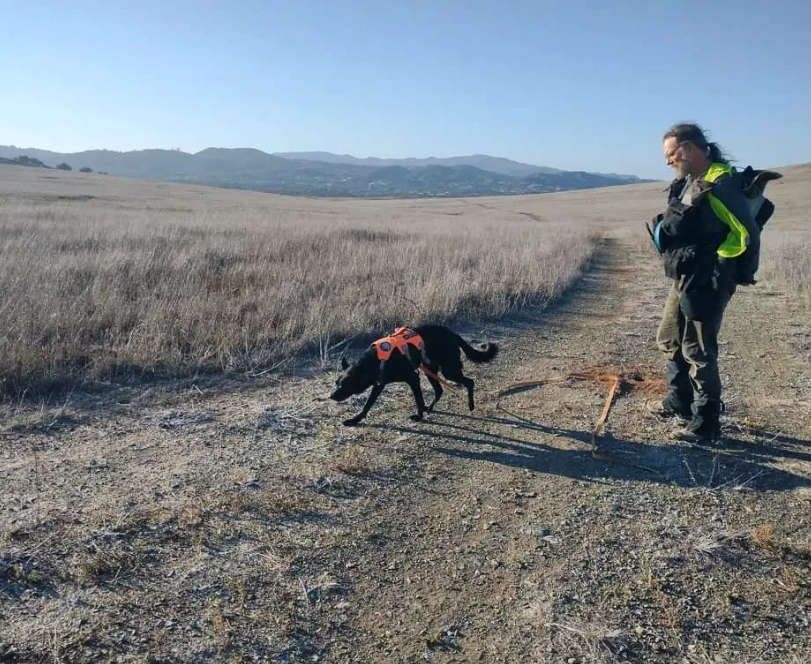
Winnie, our most experienced "lion dog" (perhaps only rivaled by Pips). She worked all three years of our project with the California Department of Fish and Wildlife in addition to many other puma concolor projects, each one alongside her bounder and Research Scientist, Justin Broderick.
Our newest "lion dog" is Whisper. She's being introduced to many new odors and species alongside her bounder, Heath Smith. Heath's main detection dog, Pips, is in semi-retirement and Whisper stepped in to fill his very big role as Heath's lead detection dog. She has more than proven she is up for the task, finding us buried and hidden data we'd never have located without her help.
And last but never least, Filson. From searching for cougars in Yosemite National Park with Yosemite Conservancy for his first project with his main bounder, Jennifer Hartman, he has gone on to search for this elusive big cat on many projects from Oregon, Washington, California and soon to be in Idaho!
There were some difficult parts of 2022, too:
 We laid to rest our sweet Alli, the matriarch of our Rogues pack. A few days before her 18th birthday, we said our final goodbyes. Alli had decided it was her time. She passed in her favorite place to be, her bounder's arms. We hope, with all our hearts, she's now with our other cowoofers we've lost. For some insane reason, we thought she'd be with us forever. She was such a fighter, so stubborn, so strong, the matriarch of our pack, our fearless leader.
We laid to rest our sweet Alli, the matriarch of our Rogues pack. A few days before her 18th birthday, we said our final goodbyes. Alli had decided it was her time. She passed in her favorite place to be, her bounder's arms. We hope, with all our hearts, she's now with our other cowoofers we've lost. For some insane reason, we thought she'd be with us forever. She was such a fighter, so stubborn, so strong, the matriarch of our pack, our fearless leader.
Alli, originally a drug-detection dog, was the last of our original conservation dogs and detected many different species throughout her tenure, including the Pacific pocket mouse, the Oregon silverspot butterfly, and the Oregon spotted frog. She launched us on the path we're on now, nearly two decades ago. We're not sure who we are now, without her, but we hope to make her memory proud with the work she helped pave the way for.
For a beautiful tribute to Alli and the work she did for Oregon Silverspot conservation, check out this video graciously made by Julia Johanos.
 Some of our followers may know that one of our detection dogs, Jack, has been fighting a rare cancer for some time. Thankfully, Jack is young, strong, and healthy still. We've been fighting this alongside his bounder, Collette; Jack has undergone multiple surgeries, but despite this his cancer has continued to spread. In 2022 Collette started a GoFundMe page for Jack to help cover the costs of his surgeries and treatments.
Some of our followers may know that one of our detection dogs, Jack, has been fighting a rare cancer for some time. Thankfully, Jack is young, strong, and healthy still. We've been fighting this alongside his bounder, Collette; Jack has undergone multiple surgeries, but despite this his cancer has continued to spread. In 2022 Collette started a GoFundMe page for Jack to help cover the costs of his surgeries and treatments.
Collette writes: "Despite the looming shadow of his cancer, Jack still loves life. He loves to play, and he thrives on learning together with his person. His favorite things in life are good food, chasing balls, and swimming. When I say this dog is everything to me, I mean it. I have spent the majority of the last six years alone except for him. He has given me everything, and I just want to do the same for him." From orca whales, to bat hibernacula, from the best snuggler to the most enduring lessons, Jack means the world to both Collette and our program.
If you would like to donate to help Jack and Collette, it would mean the world to all of us. Every little bit helps. Thank you.
Go check out the Conservation K9’s podcast about Jack—thank you to the Conservation K9 team for highlighting our special boy’s story.
What our humans were up to besides field worK:
 In May, bounders Abby and London as well as detection dog Hugo visited an elementary school to talk to 2nd-5th graders about the work that conservation detection teams do, hopefully inspiring the next generation of biologists, researchers, and conservationists!
In May, bounders Abby and London as well as detection dog Hugo visited an elementary school to talk to 2nd-5th graders about the work that conservation detection teams do, hopefully inspiring the next generation of biologists, researchers, and conservationists!
In June we hosted a workshop for volunteer dog owners and their furry friends to learn to detect an invasive plant species in western Washington. Several pet-dog/owner volunteer teams were taught how to detect and remove herb-robert (Geranium robertianum), an invasive and noxious weed that can take over healthy native plant communities and has been found in old growth forest habitats. Three yips for citizen scientists!
 In August, Rogues co-director Heath Smith traveled to Canberra, Australia to keynote at the Australasian Conservation Dog Network Conference. He spoke about how dogs are not only our best friends but our greatest teachers, and we met so many incredible people in the conservation dog field. We were also able to give a separate talk about a detection dog team's ability to detect multiple species on any given survey, thus enhancing conservation objectives.
In August, Rogues co-director Heath Smith traveled to Canberra, Australia to keynote at the Australasian Conservation Dog Network Conference. He spoke about how dogs are not only our best friends but our greatest teachers, and we met so many incredible people in the conservation dog field. We were also able to give a separate talk about a detection dog team's ability to detect multiple species on any given survey, thus enhancing conservation objectives.
In September, Rogues co-director Jennifer Hartman was invited to speak at the Student Conservation Association (SCA)’s 2nd annual Virtual Career Fair. She spoke about making your passion your profession, a subject close to her heart—Jennifer started her career through SCA internships, through which she met her first conservation dog, Max.
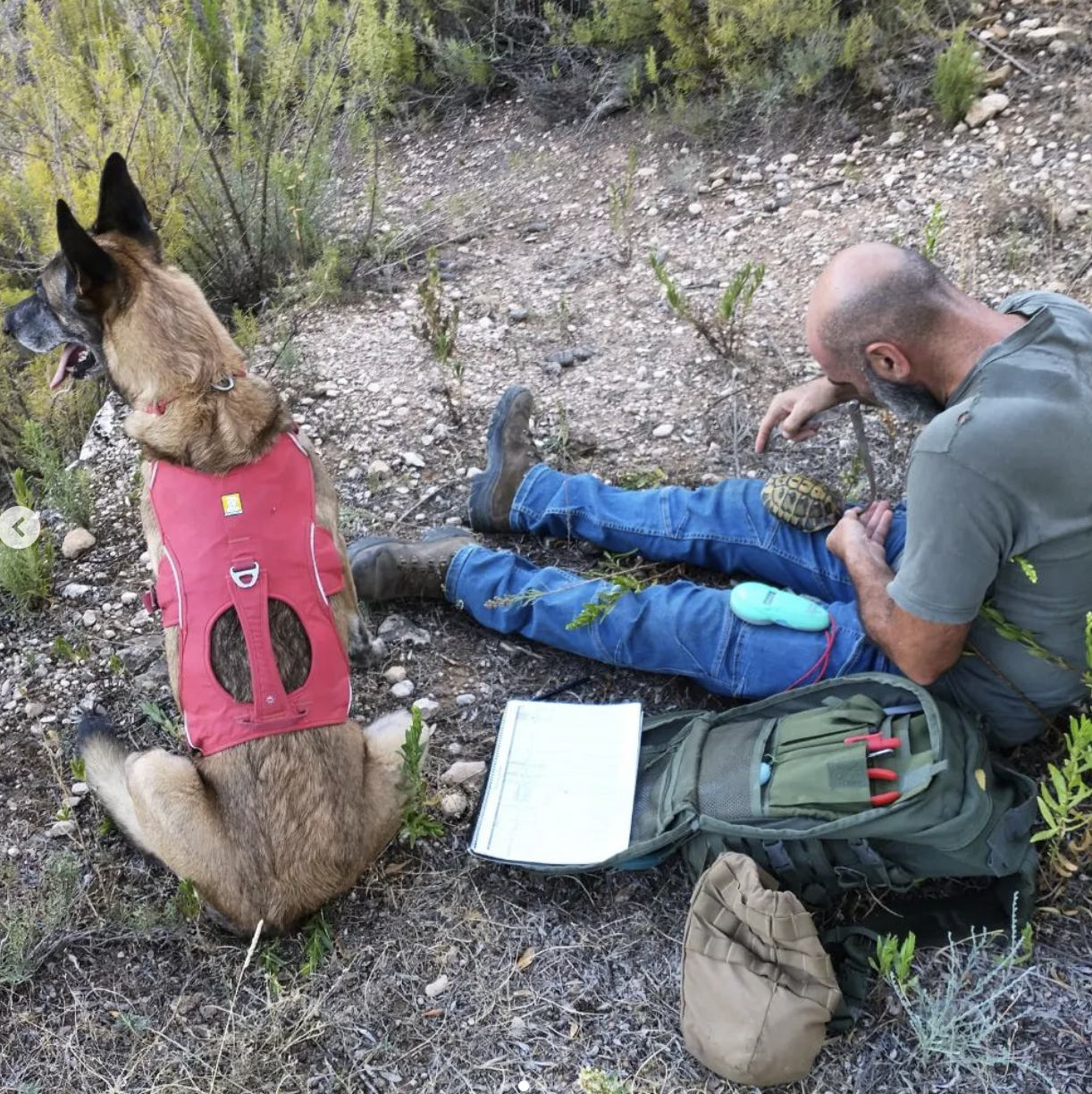 In October, Jennifer and Heath traveled to Spain to attend a detection dog conference. While there, they tagged along with fellow detection dog handler Alfonso Contreras and his two detection dogs, Jara and Olivia, to detect endangered Mediterranean tortoises. Alfonso works with EccoTrenca, who reintroduced the species to the region after they had all but disappeared.
In October, Jennifer and Heath traveled to Spain to attend a detection dog conference. While there, they tagged along with fellow detection dog handler Alfonso Contreras and his two detection dogs, Jara and Olivia, to detect endangered Mediterranean tortoises. Alfonso works with EccoTrenca, who reintroduced the species to the region after they had all but disappeared.
In October, we presented our research findings from our Palm Springs wind facility work at the Wildlife Society’s annual conference in Spokane, WA. This data was from our year-long project in 2021 with USGS and the Bureau of Land Management.
Here’s a snippet from our abstract: “To investigate the effect of repowering on avian & bat mortality rates, crews searched for carcasses that collided with turbines & we used statistical tools to estimate total mortality from observed carcass counts. In our study, conducted from 7 May 2018-26 April 2019 at wind turbine sites near Palm Springs, CA we used three professional conservation detection dog teams (CDDT) to search for carcasses. A total of 29 turbines at 5 sites (ranging from smaller, older, 108 kW turbines to larger, newer, 2500kW turbines) were searched every three days over this period."
You can read this research in the paper, "Relative energy production determines effect of repowering on wildlife mortality at wind energy facilities," published in Journal of Applied Ecology, Vol 58, Issue 6! besjournals.onlinelibrary.wiley.com/journal/13652664
New odor work:
 In preparation for future field work, in 2022 we worked on teaching our dogs new odors, including:
In preparation for future field work, in 2022 we worked on teaching our dogs new odors, including:
- Ground Squirrels
- Pond turtle nests
- Endangered Western Bumblebee nests
Every year and every season has its successes and its challenges. We're grateful and proud of the work that we did last year, and we're excited for what 2023 has in store for the Rogue Detection Teams!
Was this post a little TL;DR? Check out our 2022 wrap-up video below for a more concise summary of our year!
If you would like to hire Rogues for your next project or want to discuss the potential of working together, please check out our Hire Us page. We'd love to get in touch with you!
